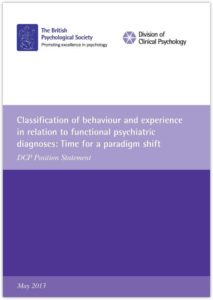[A] sum of zeros, even repeated a billion times, remains zero; likewise an accumulation of research and gains in complexity will lead to naught if there is no firm ground beneath it.
– Nassim Nicholas Taleb1
1. No objective tests
There is no objective biological test such as a blood test or scan for diagnosing mental illness.
– British Psychological Society2
Instead of objective tests, Chair of the DSM-IV Task Force, Dr Allen Frances, has admitted that all psychiatric diagnoses are based on ‘subjective judgments that are inherently fallible and prey to capricious change.’3 Several researchers4 have noted the poor inter-rater reliability of these diagnoses (i.e., the degree of agreement among diagnosticians regarding a specific diagnosis), which renders studies looking for ‘causes’ of ‘mental illness’ inherently confounded.5
rather than being developed and validated through a scientific process of pattern identification, informed by appropriate evidence-based theory, psychiatric ‘disorders’ and the criteria used to diagnose them, are voted into existence by committees, informed by theories which lack empirical support.6 7 (Emphasis added)
2. The ‘chemical imbalance’ myth
Despite a lack of objective tests, psychiatrists and Big Pharma have, for decades, claimed that people diagnosed ‘mentally ill’ have a ‘chemical imbalance’.8 The reality is that ‘[c]ontemporary neuroscience research has failed to confirm any serotonergic lesion in any mental disorder, and has in fact provided significant counterevidence to the explanation of a simple neurotransmitter deficiency.’9
A report by the British Psychological Society also stated: ‘high-profile claims for a causal ‘imbalance’ of neurotransmitters such as serotonin remain unproven10. . . . there is no consistent pattern relating serotonin (or any of the other monoamines) to the experiences associated with a diagnosis of ‘depression’.’11
Speaking more broadly, the authors of the report observed that
in relation to the great majority of psychiatric diagnoses including those experiences and behaviours labelled as schizophrenia, bipolar disorder, depression or depressive disorder, anxiety disorder, personality disorders and eating disorders, there are no consistent associations with any biological pathology or impairment, and no biomarkers have been identified.12
3. Half a century of gene-finding failures

Psychiatrists have also claimed that genetic factors play a substantial role in that which is labelled ‘mental illness’. For example, in the DSM-5, the American Psychiatric Association asserted that ‘There is a strong contribution for genetic factors in determining risk for schizophrenia’13 and that there are a number of risk alleles that each contribute a small proportion to the total population variance.
If this is true, why – in the same year that the DSM-5 was published – did its Task Force Chair, Dr David Kupfer, say that after several decades, ‘We’re still waiting’14 to discover biological and genetic markers for ‘mental illness’?
The reality is that ‘mental illness genes’ haven’t been found – or rather they were ‘found’ and then lost due to an inability to replicate the original ‘gene discoveries’.15 Several experts have acknowledged this, including the Chair of the DSM-IV Task Force, Dr Allen Frances:
Billions of research dollars have failed to produce convincing evidence that any mental disorder is a discrete disease entity with a unitary cause. Dozens of different candidate genes have been “found,” but in follow-up studies each turned out to be fool’s gold.16
The British Psychological Society has also stated: ‘no major genes of significant effect have been identified for any functional diagnosis’.17
Based on decades of failed replications, psychologist Jay Joseph wrote: ‘all gene discovery claims in psychiatry should be assumed to be false-positive associations between genes and disorders until proven otherwise.’18
4. ‘Antidepressants’ are placebos (with myriad harmful effects)
Bolstered by the ‘chemical imbalance’ myth, the general public has been convinced that drugs called ‘antidepressants’ can alleviate their negative feelings. Indeed, approximately 1 in 8 Americans are consuming ‘antidepressants’.19 Despite their popularity, the research suggests that these drugs are about as effective as placebos.
As Harvard Medical School’s Irving Kirsch wrote in 2014:
Antidepressants are supposed to work by fixing a chemical imbalance, specifically, a lack of serotonin in the brain. Indeed, their supposed effectiveness is the primary evidence for the chemical imbalance theory. But analyses of the published data and the unpublished data that were hidden by drug companies reveals that most (if not all) of the benefits are due to the placebo effect. Some antidepressants increase serotonin levels, some decrease it, and some have no effect at all on serotonin. Nevertheless, they all show the same therapeutic benefit. Even the small statistical difference between antidepressants and placebos may be an enhanced placebo effect, due to the fact that most patients and doctors in clinical trials successfully break blind. The serotonin theory is as close as any theory in the history of science to having been proved wrong.20 (Emphasis added)
In contrast to mere sugar pills, however, ‘antidepressants’ have a plethora of harmful effects, including sexual dysfunction,21 22 brain abnormalities,23 suicide,24 25 violence,26 mortality,27 28 29 and risks during pregnancy.30 31
5. Prozac should never have been approved

In the United States, corruption pervades the research and approval of drugs.32 33 34 The authors of a recent paper entitled Industry-corrupted psychiatric trials, summarised the problem as follows:
Submissions of deconstructed industry-sponsored clinical trials pass peer review and are rejected by journal editors who override peer review or by attorneys representing the journals’ owners. Moreover, the pharmaceutical and medical device industries manipulate journal editors with threats of libel actions. Finally, when journal editors and their owners such as the American Academy of Child and Adolescent Psychiatry and the American Psychiatric Association are confronted with indisputable evidence of industry fraud published in their journals, they refuse retraction. When the probability of having a ghostwritten, fraudulent, industry-sponsored clinical trial accepted for publication in a high-impact medical journal is substantially higher than the probability of having a critical, deconstruction of the same trial accepted there can be no confidence in the medical literature. In this regard, many medical journals, contrary to common opinion, are not reliable sources of medical knowledge.35
One of the most famous psychiatric drugs ever created is Prozac. It has earned Eli Lilly billions of dollars.36 Yet, according to Dr Peter R. Breggin,37 it should never have been approved for sale:
When it came time to approve Prozac, the combined efforts of the drug company and the FDA could not come up with even one good study that unequivocally supported the value of Prozac in comparison to placebo. The FDA then decided to break its own rules. It gave approval to Prozac based on its marginal effectiveness when in combination with addictive tranquilizing drugs that reduced the patients’ Prozac-induced agitation, anxiety, and insomnia. In the end, Prozac was in reality approved as a combination drug—Prozac plus sedative, addictive tranquilizers, such as Valium and Dalmane. But the medical profession and the public were never told. (Emphasis in original)
6. ‘Antidepressants’ are often prescribed in the absence of a psychiatric diagnosis
Most psychiatric drugs aren’t actually prescribed by psychiatrists. Mark and colleagues38 found that from August 2006 to July 2007, 59 percent of US prescriptions for psychiatric drugs were written by general practitioners, 23 percent by psychiatrists, and 19 percent by other physicians and non-physician providers. In addition, more and more people are being prescribed ‘antidepressants’ without receiving any psychiatric diagnoses. A 2011 study found that ‘between 1996 and 2007, the proportion of visits at which antidepressants were prescribed but no psychiatric diagnoses were noted increased from 59.5 percent to 72.7 percent.’39
7. People prefer psychotherapy to drugs
Although 1 in 6 US adults is now consuming psychiatric drugs,40 people generally prefer psychotherapeutic solutions to their problems. A meta-analysis of 34 studies found that ‘participants were 3 times more likely to express a preference for psychological treatment’41 relative to medication. Despite this, among ‘antidepressant’ users, those undergoing psychotherapy declined from 31.50 percent in 1996, to 19.87 percent in 200542 and in 2004-2005 only 1 in 10 psychiatrists were providing psychotherapy to all of their clients.43
8. Abnormal is the new normal

In 2005, it was estimated that approximately half of Americans would be afflicted by ‘mental illness’ during their lives.44 It now appears that psychiatry has succeeded in medicalising the everyday lives of the majority. Based on data from five longitudinal studies, Schaefer and colleagues reported that the proportion of participants who had received a psychiatric diagnosis ranged from 61.1 percent to 85.3 percent. The authors concluded that ‘most people will develop a diagnosable mental disorder’45 at some point in their lives and thus ‘mental illness’ is now ‘the norm, not the exception.’46 (Emphasis in original)
9. Believing ‘mental illness is an illness like any other’ does not reduce stigma
Ignoring decades of research contradicting the belief that emotional distress and ‘abnormal’ behaviour constitutes an illness akin to cancer or diabetes (a belief promoted by the American Psychiatric Association47 and SANE Australia48), attempts have been made (e.g. by the World Psychiatric Association schizophrenia campaign) to ‘educate’ the public regarding the supposed biological basis of ‘mental illness’.49 These ‘educational’ campaigns have been based on the assumption that viewing ‘mental illness as an illness like any other’ reduces the stigma associated with ‘mental illness.’ The research suggests that quite the opposite is true.
Pertaining to the ‘schizophrenia’ diagnosis, a review by Read and colleagues stated that belief in biogenetic explanations is positively correlated with ‘prejudice, fear and desire for distance’.50 More recently, Pescosolido and colleagues compared differences in public causal attributions of ‘schizophrenia,’ ‘depression,’ and alcohol dependence between 1996 and 2006, and found that although endorsement of biogenetic explanations grew, stigma did not decrease. The researchers concluded: ‘An overreliance on the neurobiological causes of mental illness and substance use disorders is at best ineffective and at worst potentially stigmatizing’.51 A review of 33 studies52 drew similar conclusions, reporting that biological conceptions of ‘mental illness’ do not reduce stigma and can actually exacerbate stigmatising attitudes.
10. People in developed countries have worse mental health outcomes

Psychiatry is assumed to be a legitimate medical speciality but research has shown that its ‘treatments’ are decreasing, rather than increasing, people’s quality of life:
[L]ong-term outcomes for serious mental disorders are worse in more industrialised than developing countries. The World Health Organisation’s international outcome in schizophrenia studies found that after two years, about two thirds of the patients in less developed countries were doing well compared to only a third of the patients in the developed countries. The researchers concluded that being in a developed country was the strongest predictor of not attaining complete remission (Jablensky, 1992).53 (Emphasis added)
When evaluating these data, both Davies54 and Whitaker55 highlighted the fact that 61 percent of patients in the developed countries were on continuous ‘antipsychotic’ drugs, compared to only 16 percent in the developing countries; suggesting that better outcomes were associated with less psychiatric drug-use.
Psychiatry’s disconcerting track record has continued into the present. Dr Thomas Insel, a former director of the National Institute of Mental Health, recently admitted that after spending 13 years and $20 billion ‘I don’t think we moved the needle in reducing suicide, reducing hospitalizations, improving recovery for the tens of millions of people who have mental illness’.56
Finally, in his 2015 book, Deadly Psychiatry and Organised Denial, Dr Peter C. Gøtzsche presented data suggesting that psychiatric drugs kill approximately half a million Americans and Europeans over the age of 65, every year.57
11. Fewer people are pursuing careers in psychiatry
The lack of evidence supporting psychiatric diagnoses and ‘treatments’ has not gone unnoticed by medical students.58 According to the authors of a 2011 paper, the number of people pursuing careers in psychiatry has ‘decreased dramatically’.59 Faulkner and colleagues60 reported that from academic year 2000-2001 to 2007-2008, US training programs in psychiatry decreased from 186 to 181, and the number of graduates dropped by almost 14 percent. The Royal College of Psychiatrists sees ‘recruitment into psychiatry at a crisis point’,61 reporting that in England, psychiatrist vacancies have doubled in four years.62 Many other European nations have reported that too few medical students are entering the field.63
12. The UN has called for a ‘revolution’ in mental health care
Addressing psychiatry’s repeated failures, the United Nations General Assembly published a report calling for ‘little short of a revolution in mental health care’,64 to overturn the prevailing biomedical paradigm:
A growing research base has produced evidence indicating that the status quo, preoccupied with biomedical interventions, including psychotropic medications and non-consensual measures, is no longer defensible in the context of improving mental health65. . . . Coercion in psychiatry perpetuates power imbalances in care relationships, causes mistrust, exacerbates stigma and discrimination and has made many turn away, fearful of seeking help within mainstream mental health services. Considering that the right to health is now understood within the framework of the Convention on the Rights of Persons with Disabilities, immediate action is required to radically reduce medical coercion and facilitate the move towards an end to all forced psychiatric treatment and confinement66. . . . For decades now, an evidence base informed by experiential and scientific research has been accumulating in support of psychosocial, recovery-oriented services and support and non-coercive alternatives to existing services. Without promotion of and investment in such services and the stakeholders behind them, they will remain peripheral and will not be able to generate the changes they promise to bring.67
 These statements mirror the views of many British psychologists68 69 70 71 72 who, for years, have called for a paradigm shift to put an end to the ‘disease’ model that enables the psychiatric labeling and involuntary confinement of psychologically distressed individuals and those otherwise considered ‘abnormal’.
These statements mirror the views of many British psychologists68 69 70 71 72 who, for years, have called for a paradigm shift to put an end to the ‘disease’ model that enables the psychiatric labeling and involuntary confinement of psychologically distressed individuals and those otherwise considered ‘abnormal’.
Afterword
With these twelve facts, you are equipped to defend against the misinformation propagated by academic psychiatry, Big Pharma, and the laypeople they target. You are free to use this knowledge to (firmly but respectfully) challenge statements you hear in passing or from loved-ones such as ‘He is mentally ill’, ‘I have a chemical imbalance and these drugs help correct it’, or any other commonly accepted falsehoods that the above facts expose. Hopefully this article has shown that by doing so, you could very well be saving someone’s life.
A version of this article was published on May 28, 2020, by Mad in America.
Footnotes
- Taleb, N. N. (2004). Fooled by randomness: the hidden role of chance in life and in the markets (2nd ed.). New York: Random House.
- British Psychological Society. (2014). Understanding psychosis and schizophrenia. Leicester: Author.
- Frances, A. (2014). Saving normal: An insider’s revolt against out-of-control psychiatric diagnosis, DSM-5, big pharma and the medicalization of ordinary life. New York: William Morrow, p. 12.
- Kirk, S. A., Gomory, T., & Cohen, D. (2013). Mad science: psychiatric coercion, diagnosis, and drugs. New Brunswick: Transaction.
- Sedarati, J. (2016). Schizophrenia’s etiology: behavioural geneticists’ research and the research they ignore. The Journal of Critical Psychology, Counselling and Psychotherapy, 16(4), 257-266.
- Johnstone, L., Boyle, M., Cromby, J., Dillon, J., Harper, D., Kinderman, P., . . . Read, J. (2018). The Power Threat Meaning Framework: Towards the identification of patterns in emotional distress, unusual experiences and troubled or troubling behaviour, as an alternative to functional psychiatric diagnosis. Leicester: British Psychological Society.
- Also see Davies, J. (2016). How voting and consensus created the Diagnostic and Statistical Manual of Mental Disorders (DSM-III). Anthropology & Medicine, 1-15. doi:10.1080/13648470.2016.1226684
- Hickey, P. (2014, June 6). Psychiatry did promote the chemical imbalance theory. Retrieved May 25, 2020, from Mad in America: https://www.madinamerica.com/2014/06/psychiatry-promote-chemical-imbalance-theory/
- Lacasse, J. R., & Leo, J. (2005). Serotonin and depression: A disconnect between the advertisements and the scientific literature. PLoS Medicine, 2(12), 1211-1216, p. 1212.
- Johnstone et al., 2018, p. 153
- Johnstone et al., 2018, p. 154.
- Johnstone et al., 2018, p. 153.
- American Psychiatric Association. (2013). Diagnostic and statistical manual of mental disorders (5th ed.). Washington, DC: Author, p. 103.
- Kupfer, D. (2013, May 3). Statement from DSM Chair David Kupfer. Retrieved May 25, 2020, from Mad in America: www.madinamerica.com/wp-content/uploads/2013/05/Statement-from-dsm-chair-david-kupfer-md.pdf
- Joseph, J. (2017). Schizophrenia and genetics: The end of an illusion. Retrieved from http://store.bookbaby.com/book/Schizophrenia-and-Genetics
- Frances, A. (2014). Saving normal: An insider’s revolt against out-of-control psychiatric diagnosis, DSM-5, big pharma and the medicalization of ordinary life. New York: William Morrow, p. 19.
- Johnstone et al., 2018, p. 159.
- Joseph, J. (2015, January 5). Quotations from the genetics “graveyard”: Nearly half a century of false positive gene discovery claims in psychiatry. Retrieved May 25, 2020, from Mad in America: http://www.madinamerica.com/2015/01/quotations-genetics-graveyard-nearly-half-century-false-positive-gene-discovery-claims-psychiatry/
- Moore, T. J., & Mattison, D. R. (2017). Adult utilization of psychiatric drugs and differences by sex, age, and race. JAMA Internal Medicine, 177(2), 274-275. doi:10.1001/jamainternmed.2016.7507
- Kirsch, I. (2014). Antidepressants and the placebo effect. Zeitschrift für Psychologie, 222(3), 128–134, p. 128.
- Montejo, A. L., Llorca, G., Izquierdo, J. A., & Rico-Villademoros, F. (2001). Incidence or sexual dysfunction associated with antidepressant agents: A prospective multicenter study of 1022 outpatients. The Journal of clinical psychiatry.
- Simonsen, A. L., Danborg, P. B., & Gøtzsche, P. C. (2016). Persistent sexual dysfunction after early exposure to SSRIs: systematic review of animal studies. International Journal of Risk & Safety in Medicine, 28(1), 1-12.
- Breggin, P. R. (2012). Psychiatric drug withdrawal: A guide for prescribers, therapists, patients and their families. Springer Publishing Company.
- Sharma, T., Guski, L. S., Freund, N., & Gøtzsche, P. C. (2016). Suicidality and aggression during antidepressant treatment: systematic review and meta-analyses based on clinical study reports. bmj, 352.
- Bielefeldt, A. Ø., Danborg, P. B., & Gøtzsche, P. C. (2016). Precursors to suicidality and violence on antidepressants: systematic review of trials in adult healthy volunteers. Journal of the Royal Society of Medicine, 109(10), 381–392. doi:10.1177/0141076816666805
- Moore, T. J., Glenmullen, J., & Furberg, C. D. (2010). Prescription drugs associated with reports of violence towards others. PLoS ONE, 5(12), e15337. doi:10.1371/journal.pone.0015337
- Maslej, M. M., Bolker, B. M., Russell, M. J., Eaton, K., Durisko, Z., Hollon, S. D., . . . Andrews, P. W. (2017). The mortality and myocardial effects of antidepressants are moderated by preexisting cardiovascular disease: a meta-analysis. Psychotherapy and Psychosomatics, 86(5), 268–282. doi:10.1159/000477940
- Coupland, C., Dhiman, P., Morriss, R., Arthur, A., Barton, G., & Hippisley-Cox, J. (2011). Antidepressant use and risk of adverse outcomes in older people: population based cohort study. BMJ, 343, d4551. doi:10.1136/bmj.d4551
- Gøtzsche, P. C. (2015). Deadly psychiatry and organised denial. Copenhagen: People’s Press.
- Eke, A. C., Saccone, G., & Berghella, V. (2016). Selective serotonin reuptake inhibitor (SSRI) use during pregnancy and risk of preterm birth: a systematic review and meta‐analysis. BJOG: An International Journal of Obstetrics & Gynaecology, 123(12), 1900-1907.
- Breggin, P. R., & Breggin, G. (2008). Exposure to SSRI antidepressants in utero causes birth defects, neonatal withdrawal symptoms, and brain damage. Ethical Human Psychology and Psychiatry, 10(1), 5-9.
- Breggin, P. R., & Breggin, G. R. (2014). Talking back to Prozac: What doctors aren’t telling you about Prozac and the newer antidepressants. New York: Open Road.
- Whitaker, R., & Cosgrove, L. (2015). Psychiatry under the influence: Institutional corruption, social injury, and prescriptions for reform. New York: Palgrave Macmillan.
- Whitaker, R. (2017, May 21). Psychiatry defends its antipsychotics: A case study of institutional corruption. Retrieved May 25, 2020, from Mad in America: https://www.madinamerica.com/2017/05/psychiatry-defends-its-antipsychotics-case-study-of-institutional-corruption/
- Amsterdam, J. D., McHenry, L. B., & Jureidini, J. N. (2017). Industry-corrupted psychiatric trials. Psychiatr. Pol., 51(6), 993–1008. doi:10.12740/PP/80136, p. 97.
- Whitaker, R. (2010). Anatomy of an epidemic. New York: Crown.
- Breggin, P. R. (2001). The antidepressant fact book: What your doctor won’t tell you about Prozac, Zoloft, Paxil, Celexa, and Luvox. Cambridge, MA: Perseus.
- Mark, T. L., Levit, K. R., & Buck, J. A. (2009). Psychotropic drug prescriptions by medical speciality. Psychiatric Services, 60(9), 1167.
- Mojtabai, R., & Olfson, M. (2011). Proportion of antidepressants prescribed without a psychiatric diagnosis is growing. Health Affairs, 30(8), 1434-1442. doi:10.1377/hlthaff.2010.1024, p. 1434.
- Moore, T. J., & Mattison, D. R. (2017). Adult utilization of psychiatric drugs and differences by sex, age, and race. JAMA Internal Medicine, 177(2), 274-275. doi:10.1001/jamainternmed.2016.7507
- McHugh, R. K., Whitton, S. W., Peckham, A. D., Welge, J. A., & Otto, M. W. (2013). Patient preference for psychological vs. pharmacological treatment of psychiatric disorders: a meta-analytic review. Journal of Clinical Psychiatry, 74(6), 595–602. doi:10.4088/JCP.12r07757, p. 7.
- Olfson, M., & Marcus, S. C. (2009). National patterns in antidepressant medication treatment. Archives of General Psychiatry, 66(8), 848-856.
- Mojtabai, R., & Olfson, M. (2008). National trends in psychotherapy by office-based psychiatrists. Archives of General Psychiatry, 65(8), 962-970.
- Kessler, R. C., Berglund, P., Demler, O., Jin, R., Merikangas, K. R., & Walters, E. E. (2005). Lifetime prevalence and age-of-onset distributions of DSM-IV disorders in the National Comorbidity Survey Replication. Archives of General Psychiatry, 62(6), 593-602.
- Schaefer, J. D., Caspi, A., Belksy, D. W., Harrington, H., Houts, R., Horwood, L. J., . . . Moffitt, T. E. (2017). Enduring mental health: prevalence and prediction. Journal of Abnormal Psychology, 126(2), 212-224. doi:10.1037/abn0000232, p. 212.
- Schaefer et al., 2017, p. 220.
- American Psychiatric Association. (2015, November). What is mental illness? Retrieved May 25, 2020, from American Psychiatric Association: https://www.psychiatry.org/patients-families/what-is-mental-illness
- SANE Australia. (2016, December 5). Fact vs myth: mental illness basics. Retrieved May 25, 2020, from SANE Australia: https://www.sane.org/mental-health-and-illness/facts-and-guides/fvm-mental-illness-basics
- Read, J., & Dillon, J. (Eds.). (2013). Models of madness: Psychological, social, and biological approaches to psychosis (2nd ed.). Hove: Routledge.
- Read, J., Haslam, N., Sayce, L., & Davies, E. (2006). Prejudice and schizophrenia: A review of the ‘mental illness is an illness like any other’ approach. Acta Psychiatrica Scandinavica, 114, 303-318, p. 303.
- Pescosolido, B. A., Martin, J. K., Long, J. S., Medina, T. R., Phelan, J. C., & Link, B. G. (2010). “A disease like any other”? A decade of change in public reactions to schizophrenia, depression, and alcohol dependence. American Journal of Psychiatry, 167(11), 1321-1330, p. 1327.
- Angermeyer, M. C., Holzinger, A., Carta, M. G., & Schomerus, G. (2011). Biogenetic explanations and public acceptance of mental illness: systematic review of population studies. The British Journal of Psychology, 199, 367-372. doi:10.1192/bjp.bp.110.085563
- Timimi, S. (2014). No more psychiatric labels: Why formal psychiatric diagnostic systems should be abolished. International Journal of Clinical and Health Psychology, 14(3), 208-215. doi:10.1016/j.ijchp.2014.03.004, p. 4.
- Davies, J. (2013). Cracked: Why psychiatry is doing more harm than good. London: Icon.
- Whitaker, 2010.
- Rogers, A. (2017, May 11). Star neuroscientist Tom Insel leaves the Google-spawned Verily for … a startup? Retrieved May 25, 2020, from Wired: https://www.wired.com/2017/05/star-neuroscientist-tom-insel-leaves-google-spawned-verily-startup/?mbid=social_twitter_onsiteshare
- Gøtzsche, P. C. (2015). Deadly psychiatry and organised denial. Copenhagen: People’s Press.
- Lambert, T. W., Turner, G., Fazel, S., & Goldacre, M. J. (2006). Reasons why some UK medical graduates who initially choose psychiatry do not pursue it as a long-term career. Psychological Medicine, 36, 679–684.
- Balon, R., Coverdale, J. H., & Roberts, L. W. (2011). Are we heading into a workforce crisis? Academic Psychiatry, 35, 1-3, p. 2.
- Faulkner et al., 2011, in Balon et al., 2011.
- Katschnig, H. (2010). Are psychiatrists an endangered species? Observations on internal and external challenges to the profession. World Psychiatry, 9, 21-28.
- BBC. (2017, November 4). Psychiatrist vacancies ‘double in four years’ in England. Retrieved May 25, 2020, from BBC: www.bbc.com/news/health-41860343
- Ryland, H., Baessler, F., Dias, M. C., De Picker, L., Da Costa, M. P., Kanellopoulos, A., . . . Birkle, S. M. (2016). The psychiatry recruitment crisis across Europe: evaluation by the European Federation of psychiatric trainees. European Psychiatry, 33, S343. doi:10.1016/j.eurpsy.2016.01.766
- United Nations. (2017, June 6). World needs “revolution” in mental health care – UN rights expert. Retrieved May 25, 2020, from OHCHR: http://www.ohchr.org/EN/NewsEvents/Pages/DisplayNews.aspx?NewsID=21689&LangID=E
- UN General Assembly. (2017). Report of the Special Rapporteur on the right of everyone to the enjoyment of the highest attainable standard of physical and mental health. United Nations Human Rights Council. Retrieved from http://www.ohchr.org/EN/Issues/Health/Pages/SRRightHealthIndex.aspx, p. 4.
- UN General Assembly, 2017, p. 15.
- UN General Assembly, 2017, p. 8.
- Kinderman, P., Read, J., Moncrieff, J., & Bentall, R. P. (2013). Drop the language of disorder. Evidence-Based Mental Health, 16, 2-3. doi:10.1136/eb-2012-100987
- Timimi, 2014.
- Division of Clinical Psychology. (2013). Classification of behaviour and experience in relation to functional psychiatric diagnoses: Time for a paradigm shift. Leicester: British Psychological Society. Retrieved from https://www.bps.org.uk/sites/bps.org.uk/files/Member%20Networks/Divisions/DCP/Classification%20of%20behaviour%20and%20experience%20in%20relation%20to%20functional%20psychiatric%20diagnoses.pdf
- Bentall, R. P. (2009). Doctoring the mind: Why psychiatric treatments fail. London: Allen Lane.
- Rapley, M., Moncrieff, J., & Dillon, J. (Eds.). (2011). De-medicalizing misery: Psychiatry, psychology and the human condition. London: Palgrave Macmillan.



